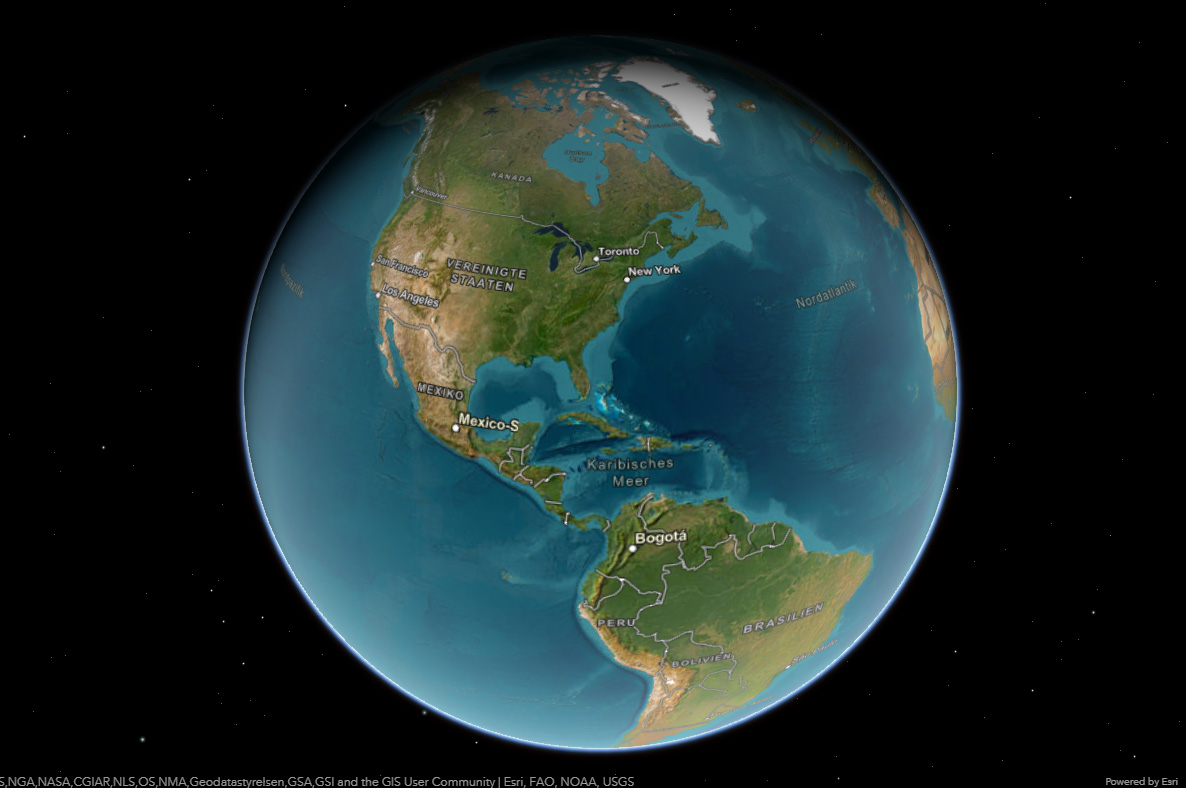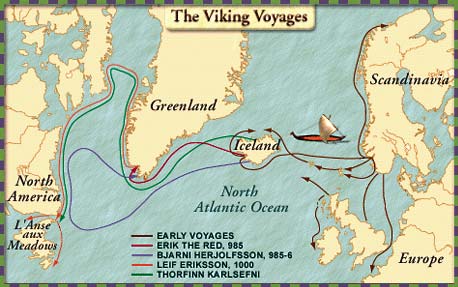Let's consider the viability of Resolution Island as Helluland's identity, since it's a natural arrival point when sailing northward from Labrador. Plus, it solves the text issue that in the Greenlanders' Saga, Bjarni's voyagers somehow see that Helluland is an island. It's worth noting that according to Traustason's Visit Vinland, among scholars, the two typical candidates for Helluland are Baffin Island and Resolution Island.
There are three options as to how the Vikings could reach Resolution Island from Labrador, and unfortunately each route causes some unlikelihoods for it to be Helluland:
Option A:
In this case, the Vikings could sail north along the Labrador Peninsula to the peninsula's northern point, and then sail north to get to Resolution Island, a distance of 55 miles, shown on the map with a red line. In this case, there are two serious incongruities the Saga that show up, as the Greenlanders' Saga says that the Vikings sailed 3 days northeast:
I. The distance from Labrador to Resolution Island is 55 miles, whereas a knarr sailing at a bit slower than a standard knarr speed would be expected to cover about 144 miles ( 3 X 12 X 4 mph). Plus, the wind was running in their favor, so one would expect the Vikings to cover even more than a standard distance.
II. The direction from Labrador to Resolution Island at their closest points would run close to directly northward from Labrador, whereas the Saga says that the Vikings sailed northeast.
Neither problem I nor II is literally insurmountable, since they could have sailed in a very roundabout way. But this route seems unrealistic.
Option B:
Suppose that the Vikings took a different route to get from Labrador to Resolution Island. One alternate departure point is farther east down the Labrador Atlantic coast. That way, the Vikings could sail anywhere from the 55 miles to even the maximum 468 miles to get to their arrival point in 3 days. However, even though that eastward shift in the departure point would solve the problem of the expected distance, it would create two problems:
I. This route would mean that the Vikings would be sailing northwest to get to Resolution Island instead of sailing northeast, whereas the Saga gives a northeast trajectory.
II. The Vikings would be practically sailing almost along and parallel to the Labrador coast for much of that route, and thus likely in sight of land. In contrast, the Saga speaks as if the Vikings departed the land directly northeast.
Option C:
The Vikings could depart northeastward from a spot inside of Ungava Bay such as near Leaf River, as the pink line shows. This route could take them 210 miles, which would be somewhere around what one might expect for a three day journey. This route would also solve the problem of direction, as they would be sailing northeast to get to Resolution Island. Nonetheless, Option C is problematic because:
I. For them to get from the Atlantic coast to Leaf River, they would have to sail to the north end of Labrador and then sail southwest to Leaf River, whereas their goal was to get to Greenland, which was far to their northeast.
II. Further, the general impression from the text that I get is that they were sailing in the same general direction with the same general wind direction from the time when they got to Markland until they left it. However, this impression is not an absolute.
III. For the Vikings to sail from the Leaf River area to Resolution Island, they would almost be doubling back against the route that they had come to from Labrador, whereas it would be more simple logistically for them to just sail north from Labrador's north end.
Options A, B, and C all share another potential distance problem, namely that if one interprets Helluland to be the same landmass in each of the two Sagas, then Eric the Red's Saga would entail that it's at most two days' sail north from Markland/Labrador. This 2 day route would run along the red line from Killiniq to Resolution Island. Thus, Options B and C would match Resolution Island's 3 day distance from points on the Labrador Peninsula, but the 55 miles from Killiniq to Resolution Island still looks too short for a 2 day journey.
In fact, even if one were not to interpret the two Sagas as referring to the same landmass as Helluland, Eric the Red's Saga still presents the problem of the closeness of Resolution Island's 55 miles to Labrador in contrast to the 2 days' sail described in Eric the Red's Saga.
Another issue is that you would have to conclude that the Bjarneyar would have to be outlying seashore islands on the east side of Baffin Island for the VIkings in Eric the Red's Saga to make a 2 day journey south from Bjarneyar to Helluland, and in that case, it seems a little puzzling that the Vikings would mention the Bjarneyar instead of mentioning Baffin Island right next to them, although I suppose in that case Baffin Island could be Bjarneyar. However, Baffin Island doesn't work very well for Bjarneyar because it's 23 to 59 miles from Baffin Island to Resolution, depending on the route that one takes, whereas Eric the Red's Saga says that the journey from Bjarneyar to Helluland was two days, and the minimum that one would expect for a two day journey would be 96 miles (2 doegr X 12 hr/doeger X 4 mph)
Thus, it seems conceivable that Resolution Island could be Helluland, but there are a line of unlikelihoods with this identification.

(click to expand)
There are three options as to how the Vikings could reach Resolution Island from Labrador, and unfortunately each route causes some unlikelihoods for it to be Helluland:
Option A:
In this case, the Vikings could sail north along the Labrador Peninsula to the peninsula's northern point, and then sail north to get to Resolution Island, a distance of 55 miles, shown on the map with a red line. In this case, there are two serious incongruities the Saga that show up, as the Greenlanders' Saga says that the Vikings sailed 3 days northeast:
I. The distance from Labrador to Resolution Island is 55 miles, whereas a knarr sailing at a bit slower than a standard knarr speed would be expected to cover about 144 miles ( 3 X 12 X 4 mph). Plus, the wind was running in their favor, so one would expect the Vikings to cover even more than a standard distance.
II. The direction from Labrador to Resolution Island at their closest points would run close to directly northward from Labrador, whereas the Saga says that the Vikings sailed northeast.
Neither problem I nor II is literally insurmountable, since they could have sailed in a very roundabout way. But this route seems unrealistic.
Option B:
Suppose that the Vikings took a different route to get from Labrador to Resolution Island. One alternate departure point is farther east down the Labrador Atlantic coast. That way, the Vikings could sail anywhere from the 55 miles to even the maximum 468 miles to get to their arrival point in 3 days. However, even though that eastward shift in the departure point would solve the problem of the expected distance, it would create two problems:
I. This route would mean that the Vikings would be sailing northwest to get to Resolution Island instead of sailing northeast, whereas the Saga gives a northeast trajectory.
II. The Vikings would be practically sailing almost along and parallel to the Labrador coast for much of that route, and thus likely in sight of land. In contrast, the Saga speaks as if the Vikings departed the land directly northeast.
Option C:
The Vikings could depart northeastward from a spot inside of Ungava Bay such as near Leaf River, as the pink line shows. This route could take them 210 miles, which would be somewhere around what one might expect for a three day journey. This route would also solve the problem of direction, as they would be sailing northeast to get to Resolution Island. Nonetheless, Option C is problematic because:
I. For them to get from the Atlantic coast to Leaf River, they would have to sail to the north end of Labrador and then sail southwest to Leaf River, whereas their goal was to get to Greenland, which was far to their northeast.
II. Further, the general impression from the text that I get is that they were sailing in the same general direction with the same general wind direction from the time when they got to Markland until they left it. However, this impression is not an absolute.
III. For the Vikings to sail from the Leaf River area to Resolution Island, they would almost be doubling back against the route that they had come to from Labrador, whereas it would be more simple logistically for them to just sail north from Labrador's north end.
Options A, B, and C all share another potential distance problem, namely that if one interprets Helluland to be the same landmass in each of the two Sagas, then Eric the Red's Saga would entail that it's at most two days' sail north from Markland/Labrador. This 2 day route would run along the red line from Killiniq to Resolution Island. Thus, Options B and C would match Resolution Island's 3 day distance from points on the Labrador Peninsula, but the 55 miles from Killiniq to Resolution Island still looks too short for a 2 day journey.
In fact, even if one were not to interpret the two Sagas as referring to the same landmass as Helluland, Eric the Red's Saga still presents the problem of the closeness of Resolution Island's 55 miles to Labrador in contrast to the 2 days' sail described in Eric the Red's Saga.
Another issue is that you would have to conclude that the Bjarneyar would have to be outlying seashore islands on the east side of Baffin Island for the VIkings in Eric the Red's Saga to make a 2 day journey south from Bjarneyar to Helluland, and in that case, it seems a little puzzling that the Vikings would mention the Bjarneyar instead of mentioning Baffin Island right next to them, although I suppose in that case Baffin Island could be Bjarneyar. However, Baffin Island doesn't work very well for Bjarneyar because it's 23 to 59 miles from Baffin Island to Resolution, depending on the route that one takes, whereas Eric the Red's Saga says that the journey from Bjarneyar to Helluland was two days, and the minimum that one would expect for a two day journey would be 96 miles (2 doegr X 12 hr/doeger X 4 mph)
Thus, it seems conceivable that Resolution Island could be Helluland, but there are a line of unlikelihoods with this identification.

(click to expand)
Last edited:












